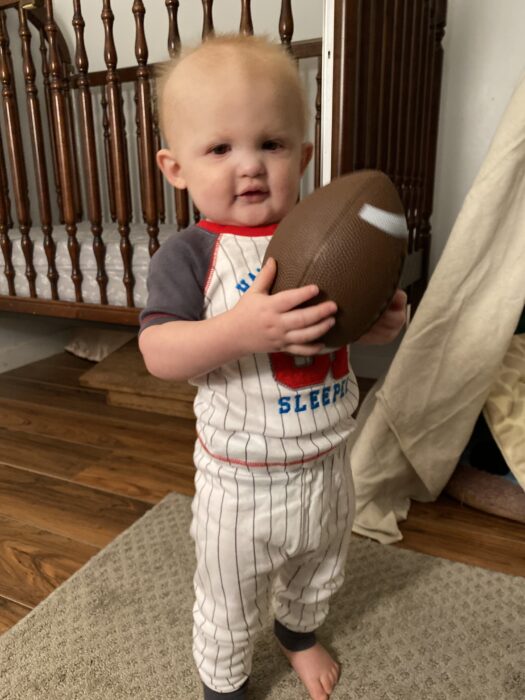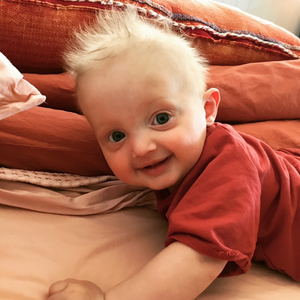We’re excited to share with our community a new guide to help families navigate the first year of life for their baby affected by hypohidrotic ectodermal dysplasia (HED). It’s a wonderful resource whether HED runs in your family or you’re brand new to the disorder.
This new, comprehensive resource is titled, A Guide to the First Year of Life: Hypohidrotic Ectodermal Dysplasia, written by Dr. Cory Jonak, Dr. Elaine Siegfried and Dr. Tim Fete. If you are pregnant with a child with HED or have an affected baby, you will find extensive information to help you know what to expect that first year. You will learn about the typical symptoms as well as best practices for their prevention and treatment. We typically talk about how HED affects the teeth, sweat glands and hair. But, the condition can also affect many other body parts.
Reading the new guide will give you a more complete picture of what your child may experience:
- Dry skin, eczema, diaper rash, cradle cap, increased redness, peeling skin, Increased and Decreased Skin Pigmentation (Hyperpigmentation and Hypopigmentation)
- Thin, sparse hair
- Nail abnormalities
- Sebaceous hyperplasia
- Identification, Management & Prevention of Overheating in an Infant
- Difficulties with Mucous and Secretions: nose, ears, airways
- Difficulties With Feeding & Weight Gain: breastfeeding, lack of teeth, reduced saliva, introducing solid foods
- Child Development and Other Information That Should Be Shared with your Doctor: hearing loss, difficulties with vision
Here are three highlights from the guide.
HED Babies and Overheating
The hallmark feature of HED is an inability to sweat (hypohidrosis), due to fewer and poorly functioning sweat glands. In infants, this will present as overheating. After your baby is born, it’s important that he is not placed under heat lamps in the hospital. You will also want to dress him in light, breathable clothing. Swaddling may make him too hot.

It’s important to know the warning signs of overheating, such as red ears, and to take steps to prevent this from happening to your little one.
“Easily identifiable signs of overheating include skin flushing (redness), decreased activity or increased restlessness, fussiness, being warm to the touch, unexplained fever, and increased heart rate,” said Dr. Jonak.
Rebecca Reynolds has learned things to do to help her son, Lucas (who has HED) stay cool.

“Lucas does not seem to sweat at all,” Rebecca said. “When he was a baby, I put him in really thin, long cotton pajamas with feet. Now at 3, he will wear short pajamas during the summer.
Shay Collins has also found cooling tricks to help her son who is affected by HED.
“For an Autumn baby in sub-tropical Australia, the temperature was mild, though we noticed Ruben didn’t like to be swaddled, and needed lighter layers than the rest of us. Later that year as the summer warmth emerged, we found ourselves carrying a water spray bottle everywhere, or using a wet flannel to cool his face and body. He radiated heat. This cooling approach was especially important in the car; in those hot car seats generally, and always if the car had been parked for any period in the sun. We also bought a USB-powered fan to direct cooled air to the back seat.”
You can find more cooling tips in the new Guide and in our Cooling Guide.
How to Treat Your HED Baby’s Dry Skin and Eczema
Dry, sensitive skin and eczema are also very common in HED babies. The new guide explains these symptoms and offers treatment options and tips to help keep the skin moisturized and prevent flare-ups.
“Dry skin is most effectively treated with frequent bathing (up to once a day). Soaking in a tub can help add moisture, as long as cleansing products are gentle and used sparingly. Avoid products with fragrance, and foamy detergents. Use cleansing products only on areas that need cleaning, such as the diaper area and skin folds. Most importantly, immediately after removing your child from the bath, gently pat the skin dry and apply a moisturizer to help seal in the moisture. The safest and most effective moisturizer is plain petroleum jelly.”

Rebecca says that she uses Phisoderm body wash in the bath for Lucas.
“It never breaks him out and is for sensitive baby skin. We just use Aquaphor afterwards. I’ve been told that you can talk to your pediatrician and they can send some kind of note and you can get 12 jars for free! Ask your doctor about it.”
Shay Collins has found some natural moisturizers to help treat her son Ruben’s dry skin and eczema.

“Ruben seemed more dry overall as a baby and we used some natural moisturizers and baby oils which worked well. Later, when his skin seemed more eczema-effected, we found a locally made natural eczema and psoriasis cream that really cleared things up.”
Preventing and Treating Nasal Rocks in Babies Affected by HED
Besides skin, HED can also affect certain glands in the body.
Children with HED tend to have a reduced number of mucous glands, which also produce an abnormal form of mucous. The places where we find these mucous glands causing the most issues are in the nose, the ears, and the airways (respiratory tract).
– Dr. Cory Jonak
One of the more challenging symptoms is treating and preventing the “nasal rocks” that your baby is likely to have. Your HED child’s mucous glands don’t function normally, which can lead to the nasal passages drying out. The mucous may get so thick that it develops into hard, crusty “nasal rocks” that can make it difficult for your little one to breathe. It can also be foul smelling and put them at an increased risk for a sinus infection.
Keeping your child’s nasal passages moist will help prevent mucus from accumulating. Humidifiers, saline spray and nasal bulbs can all be helpful.
If you are the parent of a child with HED, you likely know exactly what we mean by nasal rocks! Families have shared their shock and stories about what they have extracted from their little ones’ noses.
Irrigating the Nose
Rebecca believes that you can never saline too much. Their routine includes saline rinses in the morning, afternoon and at night. She also recommends using saline gel (they use ayr saline gel), by using a small applicator to rub it inside the nostrils.
“When Lucas was born, he snorted all the time. I was thinking this can’t possibly be normal. He would get so stopped up that he couldn’t even drink his bottle. We use the Boogie Mist. What I’ve learned is that the more you saline, the less stopped up he will be and the easier it is to get it out. Plus, his nose will stay moisturized.
– Rebecca Reynolds

“You have to REALLY use a lot of saline because you have to get those hard rocks out before the rest comes and it’s tough. Make sure he is sitting up while you saline him. The snot and stuff is so far back and I don’t think we realized that at first.”
Of course, your young one might not enjoy multiple saline rinses throughout the day. Rebecca has gotten creative with her son to make it a more enjoyable experience by taking advantage of bath time.
“As he gets older, bath time will be your best friend with his nose,” Rebecca said. “It’s a great time to get water up there and splash him while he thinks you are playing.”
Supporting You. Supporting Each Other.

We know caring for a baby with HED may feel overwhelming at first, as you learn your child’s unique needs. Children with HED can differ in how they express symptoms. But, we hope that this new guide will give you the information and tips you need to help you manage that first year (and beyond). Just know that you can do this…and all is going to be just fine…for you and your little one! As always, know that our staff is just a phone call away to answer any questions you have and to offer you our support.
Download Our HED Baby GuideYou may also consider joining our private HED Facebook group. It’s a great way to connect with other families and learn from one another.
If you have a child (even an adult child) with HED, what worked well for you that first year? Tell us in the comments below.

